ISSN ONLINE(2319-8753)PRINT(2347-6710)
ISSN ONLINE(2319-8753)PRINT(2347-6710)
Janki.H.Vyas 1, Narendra.J.Shrimali 2, Mukesh.A.Modi 3
|
| Related article at Pubmed, Scholar Google |
Visit for more related articles at International Journal of Innovative Research in Science, Engineering and Technology
Pipe network analysis is the fluid flow through a hydraulics network containing several or many inter connected branches whose aim is to determine the flow rates and pressure drops in the individual sections of the network. Classical approach for automatically solving the problems of network is by using specialized software such as EPANET. The purpose of this study is to assess the performance of Dhrafad regional water supply scheme using hydraulic simulation software and to address any improvements required to existing infrastructure and/or the mode of operation, in order to improve quantity and quality of water distributed to the consumers.
Keywords |
| Water distribution; simulation; performance; water demand; water demand; pipe flow |
INTRODUCTION |
| Water distribution networks serve many purposes in addition to the provision of water for human consumption, which often accounts for less than 2% of the total volume supplied. Piped water is used for washing, sanitation, irrigation and fire fighting. Networks are designed to meet peak demands; in parts of the network this creates low-flow conditions that can contribute to the deterioration of microbial and chemical water quality. |
| The purpose of a system of pipes is to supply water at adequate pressure and flow. However, pressure is lost by the action of friction at the pipe wall. The pressure loss is also dependent on the water demand, pipe length, gradient and diameter. Several established empirical equations describe the pressure–flow relationship (Webber, 1971) and these have been incorporated into network modelling software packages to facilitate their solution and use. |
| When designing a piped system, the aim is to ensure that there is sufficient pressure at the point of supply to provide an adequate flow to the consumer. For Example, in England and Wales, water companies are required to supply water to a single property at a minimum of 10 m head of pressure at the boundary stop tap with a flow rate of 9 l/min (OFWAT, 1999). This minimum pressure increases as the number of properties supplied through a single service pipe increases. |
| The purpose of this study is to assess the performance of Dhrafad regional water supply scheme of Visavadar taluka of Junagadh district of Gujarat state using hydraulic simulation software and to address any improvements required to existing infrastructure and/or the mode of operation, in order to improve quantity and quality of water distributed to the consumers. |
STUDY AREA |
| Dhrafad regional water supply scheme includes 31 villages of Visavadar taluka of having population of 56660. The source of Dhrafad regional water supply scheme is Dhrafad dam situated near village Sarsai on Dhrafad River at Visavadar taluka. |
| From Dhrafad dam i.e. surface source the raw water is pumped to the water treatment plant of capacity 7.50 MLD. The treated water is then distributed to the village G.L. Cisterns through service reservoirs G.L. sump or elevated water tanks. For proper use of water, the distribution gravity main system is divided into four zones 1, 2, 3, 4A & 4B. The ultimate distribution is through internal pipeline and stand post. The distribution system includes 2 elevated service reservoir, sump and pump house with machinery gravity main and rising main pipeline. |
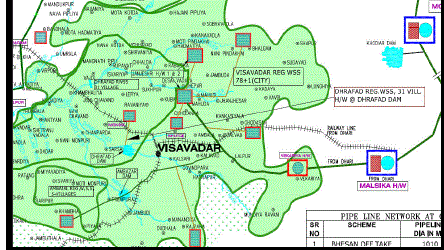 |
| The map of Dhrafad distribution system was obtained and was inserted in EPANET screen for hydraulic simulation of network. |
| A) About Epanet |
| EPANET is a computer program that performs extended period simulation of hydraulic and water quality behavior within pressurized pipe networks. A network consists of pipes, nodes (pipe junctions), pumps, valves and storage tanks or reservoirs. EPANET tracks the flow of water in each pipe, the pressure at each node, the height of water in each tank, and the concentration of a chemical species throughout the network during a simulation period comprised of multiple time steps. In addition to chemical species, water age and source tracing can also be simulated. |
| EPANET is designed to be a research tool for improving our understanding of the movement and fate of drinking water constituents within distribution systems. It contains a state-of-the-art hydraulic analysis engine that includes the following capabilities: (Rossman, 2000). |
| places no limit on the size of the network that can be analyzed |
| computes friction head loss using the Hazen-William, Darcy-Weisbach or Chezy-Manning formula |
| includes minor head losses for bends, fittings, etc. |
| models constant or variable speed pumps |
| computes pumping energy and cost |
| models various types of valves including shutoff, check, pressure regulating, and flow control valves |
| allows storage tanks to have any shape (i.e., diameter can vary with height) |
| considers multiple demand categories at nodes, each with its own pattern of time variation |
| models pressure-dependent flow issuing from emitters (sprinkler heads) |
| can perform system operation on both simple tank level and timer controls and on complex rule-based controls. |
| EPANET's Windows user interface provides a network editor that simplifies the process of building piping network models and editing their properties. Various data reporting and visualization tools such as graphical views, tabular views, and special reports, and calibration are used to assist in interpreting the results of a network analysis (EPA, 2000). |
| EPANET models a water distribution system as a collection of links connected to nodes. The links represent pipes, pumps and control valves while the nodes represent junctions, tanks and reservoirs. The figure below shows the physical components of a distribution system (Rossman, 2000). |
| Creating A Model: From toolbars selected reservoirs for sump, nodes for junction, pipes and tank and generated Dhrafad regional water supply scheme map. Also gave Hazen-William formula for head loss calculation and set default unit of flow as l/s. |
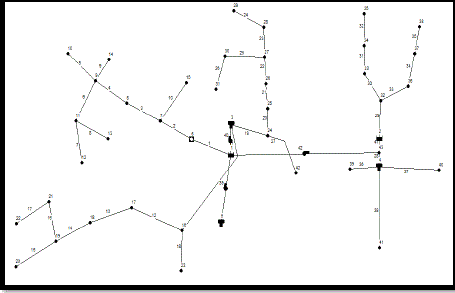 |
| Further following tasks were carried out: |
| Values of elevations assigned to nodes and tank. |
| Add pipe length and diameter. |
| Values of total head assigned to reservoir and pump. |
| Editing time pattern and pump curve. |
| Run the network (If the run was unsuccessful than the status report window will appear indicating what the problem was. If it ran successfully you can view the computed results) |
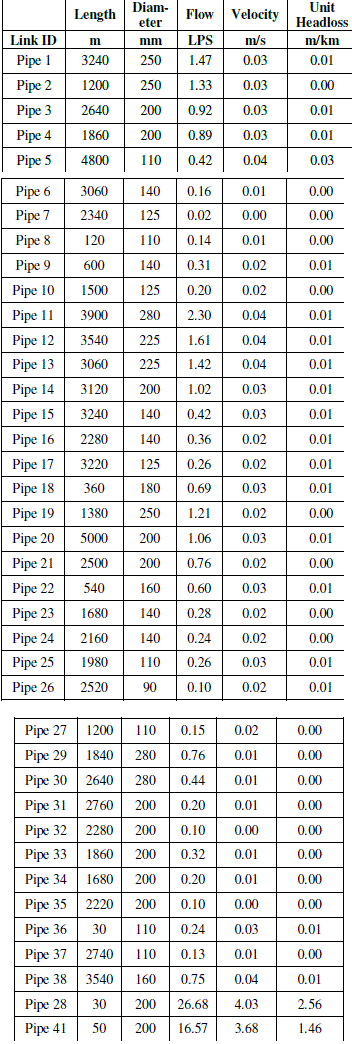 |
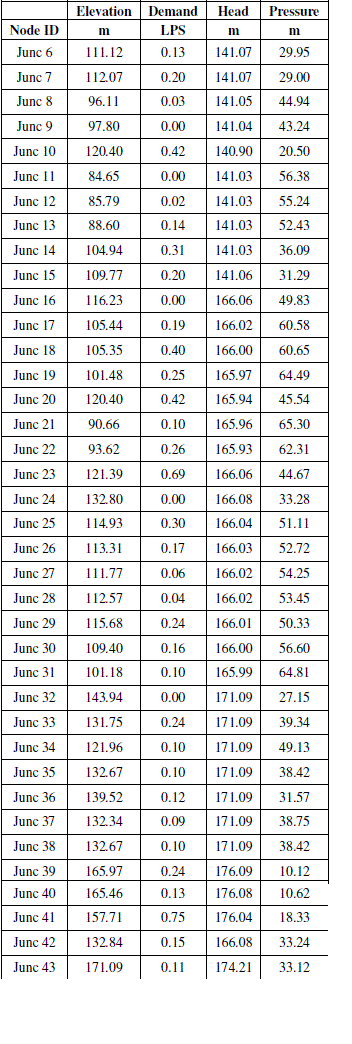 |
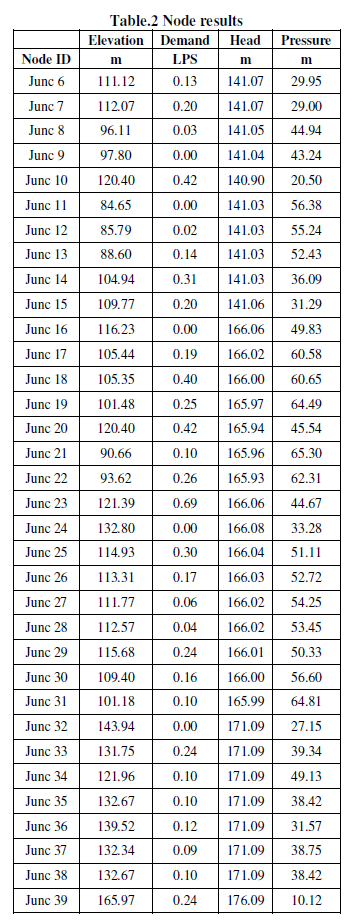 |
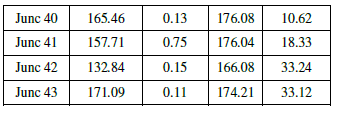 |
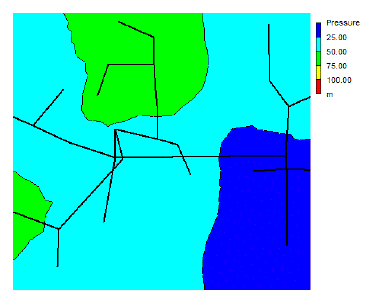 |
| Table.1 and 2 represents the results of flow, velocity and unit headloss developed at pipe and head, pressure and demand developed at nodes or junctions at 0:00 hrs in pipe network of 31 villages of Dhrafad regional water supply system. Fig. 3 represents the contour plot for pressure of the system. Similarly, the results for pipe and node are obtained for total time duration taken. |
CONCLUSION |
| The optimized design done gives an output or result with minimum head loss and economical diameter. In accordance with these appropriate head is achieved with passage of desired flow at sufficient velocity through the pipe system. Overall about 70% of uniform pressure is obtained for larger portion of command area. Variations in head, velocity and unit headloss during peak hours is observed within standard criteria. |
References |
|